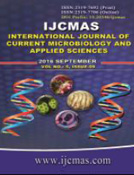


 National Academy of Agricultural Sciences (NAAS)
National Academy of Agricultural Sciences (NAAS)

|
PRINT ISSN : 2319-7692
Online ISSN : 2319-7706 Issues : 12 per year Publisher : Excellent Publishers Email : editorijcmas@gmail.com / submit@ijcmas.com Editor-in-chief: Dr.M.Prakash Index Copernicus ICV 2018: 95.39 NAAS RATING 2020: 5.38 |
Cephalosporins and ciprofloxacin are commonly used in the treatment of gram negative bacilli infections. Third generation cephalosporins are first choice but expensive than ciprofloxacin. So there is a need to compare their susceptibility. To compare the susceptibility of gram negative bacilli clinical isolates to cephalosporins and ciprofloxacin. Susceptibility of ESBL and AmpC producers to ciprofloxacin. Disk diffusion method performed on200 Gram negative bacilli isolates. Susceptibilityto cefuroxime, cefotaxime, ceftazidime, ceftazidime with clavulanic acid, cefoxitin, cefepime and ciprofloxacin were tested. ESBL detected by>7mm zone with ceftazidime clavulanic acid than ceftazidime alone. AmpC detected by cefoxitin resistant and cefepime sensitive. Pseudomonas isolates exudates 14 (29%), burns 26(54%), bood 8(17%). Susceptibility to ciprofloxacin, cefepime in exudate 8(57%), 6(43%), burns 10(38%), 8(31%) respectively. Blood isolates susceptible to cefepime 6(75%) other cephalosporins and ciprofloxacin4(50%). Escherichia coli isolates 14 (28%) exudates, 6(12%) blood, 14 (28%) sputum and 18(36%)urine. Blood isolates100% susceptibility to ciprofloxacin, cefepime Exudate 4(28%),8(57%). Equal susceptibility to both 8(57%) sputum. Urine 12(66%), 14(78%) respectively. Klebsiella 20(32%) exudates and burns, 20(32%)sputum,4(6%)blood. Their susceptibility to ciprofloxacin 4(22%) 2(11%),10(50%) and cefepime 4(22%), 4(22%), 2(50%), 10(50%) respectively. Enterobacter blood 12(50%), exudate, burns sputum 4(17%) each. Susceptibility to ciprofloxacin 4(100%) exudates and burns, 8 (67%) blood. Resistance to cefepime seen in all except blood isolates 8(67%). Citrobacter isolates from exudates 6 (60%), from blood and urine2(20%) each.Exudate2(33%) sensitive to all cephalosporins and ciprofloxacin. Blood, urine1(100%) sensitive to ciprofloxacin. Acinetobacter 6(100%) exudates.2(33%) sensitive only to cefepime Ciprofloxacin susceptibility seen in Pseudomonas 54%, E.coli 72%, Klebsiella 29%, Enterobacter 66%, Citrobacter 80% and Acinetobacter resistant and cefepime susceptibility 21%, 60%, 25%, 41%, 40% and 33% respectively. Among 8 ESBL, 5 AmpC producers 4(50%) and 2(40%) sensitive to ciprofloxacin respectively. Ciprofloxacin was found to be more active than the fourth generation cephalosporin cefepime against gram negative bacilli. Since ciprofloxacin are cheaper it reduces the treatment cost.
 |
 |
 |
 |
 |